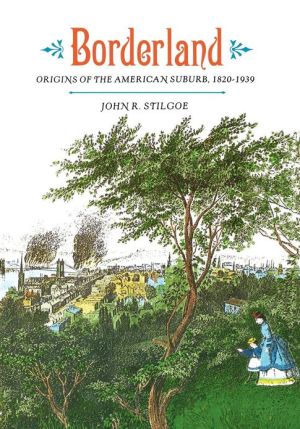

 |

|

The average rating for Borderland: Origins of the American Suburb, 1820-1939 based on 2 reviews is 4 stars.
Review # 1 was written on 2018-06-16 00:00:00 Tyler Andrassy Tyler AndrassyIt opens with a very brief account of the use of "suburb" as a pure insult -- the poor region outside the city walls, vulnerable to attack. And onward to the transitions. The healthiness of country living. The disgust with slovenly farming, and its economic problems and the dangers of pollution. The flower garden as a sign of leisure. The rigidly controlled neighbors for the professionals. The problem of transport. How to build the houses and structure the garden for privacy. And more |
Review # 2 was written on 2018-04-28 00:00:00 Gary J. Samoil Gary J. SamoilUnlike the other reviewers, I'd never heard of John Stilgoe prior to reading this book. The book was given to me by a friend when she was moving, and of the 40 or so books in the pile she left for me, this was one of a few that caught my eye. It's a thoughtful and articulate, if somewhat repetitive, look at the emergence and evolution of both what we today would call inner and outer suburbs -- with the outer ones reflecting Stilgoe's term "borderlands." The book starts on a very strong note, as the author explains the origins of suburbs in medieval Europe and then quickly transitions to the earliest suburban (or non-urban existences) in the U.S. Of course, those had to wait until cities actually developed in the late 18th century, at which point some people quickly decided that they were dens of iniquity, and that the solution was the countryside. This was a radical thought at the time, given that most people thought of the country as untamed and dangerous -- which it basically was. The book moves fluidly from the late 18th century through to the early 20th, showing how different fashions took the hearts, minds and wallets of home owners and the architects and planners who marketed to them. The biggest takeaway is that these borderlands really were the domain of the wealthy. These were not suburbs for the clerk or schoolteacher. They were for merchants and very successful lawyers. And this remained the standard for about a century, until horse-drawn streetcars, railroads, trolleys and, eventually, cars brought greater access to borderlands for others. So with this elite focus, the borderlands were the place where estates of 10 acres or even hundreds of acres were purchased. In the early days, they were working farms, for which the wealthy landowner had workers, but which he might do a little bit of toil on his free hours. The idea was that these demonstrated to the regular farmers how they should be -- how they could adopt the latest knowledge about grafting, fertilizer, etc. -- and how they should keep their farms clean. But as the author points out, only gentlemen farmers could afford to run their model farms at a loss. Their neighbors actually needed to produce crops that would sell, rather than a handful of fruit trees and exotic flowers. Eventually, this farm-like borderland became swallowed by expanding inner suburbs, spurred by rail lines and streetcar service. The grand farms were cut up into lots and developments. The borderlands shifted further out -- instead of 5 miles from the city, they might be 10 or even 20. And they evolved from farms to estates, on which wealthy owners would show off their imported trees and flowers, and would site their houses in ways to see grand vistas. Meanwhile, for the merely well-to-do, borderland villages were created, perhaps with lots of an acre, from which they could commute to their city jobs. The book does a lovely job of describing some of the best known of those borderland villages, celebrated in their times even when ultimately they didn't always succeed either (Forest Hills Gardens, Shaker Heights, etc.). The book is full of pictures, which is a big help. Actually, seeing the images of the borderland villages that were developed makes me want to visit them today to see what of the landscape and of the architecture remains. I've been to one of those areas, Baltimore's Roland Park, and it's lovely. Feels like the classiest suburb you've ever seen, and it's only a few miles north of downtown. And surely that's why the homes there are still desirable. |
CAN'T FIND WHAT YOU'RE LOOKING FOR? CLICK HERE!!!